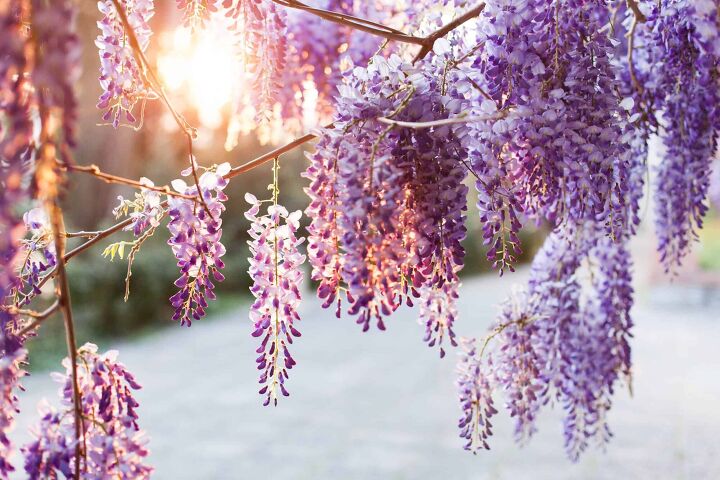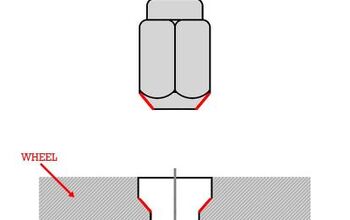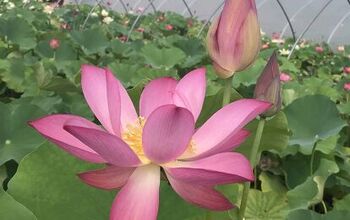12 Different Types of Wisteria (with Photos)

Blooming in shades of pink, purple, lilac, and white, vibrant wisteria vines and trees are beautiful flowering plants that are perfect for the nostalgic gardener. Their heavy, dangling clusters of flowers and twisted branches fill garden landscapes with fragrance and color. Wisteria grows up to an astounding 12 feet in a single growing season, making it very quick and easy to train the vine up a pergola or arbor.
The 12 types of wisteria include wisteria sinensis, wisteria floribunda, pink Japanese wisteria, and blue moon wisteria vine. Chinese wisteria, amethyst falls American wisteria, and scarlet wisteria are among the most unique types. Varieties like Silky wisteria and Kentucky wisteria are some of the most popular types of wisteria.
If you’re unsure of which type of wisteria to add to your garden, you’ve come to the right place. Continue reading for our comprehensive guide on these striking plants, so you can fill your summer and spring gardens with vibrant hues.
Wisteria Overview
A genus of flowering plants in the legume family, Fabaceae, wisteria is long-lived, vining, and offers cascades of blue to purple, and even pink and white blooms. The flowers are highly desirable for adorning an archway or pergola in spring and early summer. This vine is known to be incredibly fast-growing, often reaching over thirty feet long and can be quite heavy.
The flowers that wisteria produce are wildly fragrant, providing a pleasant feast for your senses. Though, wisteria blooms only emerge on new growth. After flowering, a brown pod (similar to a bean) will persist on the plant until winter. Wisteria plants will find their way into every nook and cranny that they come into contact with. As such, it’s not recommended to plant them too close to your home.
A note of caution: Wisteria should be planted with caution, as all parts of the plant contain substances known as wisterin and lectin. These substances are toxic to humans, pets, and livestock. They can cause any reaction from nausea to diarrhea, and even death if consumed in large quantities.
Types of Wisteria
When you compare the various types of wisteria, the choice ultimately comes down to availability and aesthetics. The most commonly grown species in the United States are Chinese wisteria and Japanese wisteria, which have become a favorite among gardeners for their powerful fragrance, showy bloom clusters, and many color and cultivar options.
However, these aren’t the only types of wisteria you have to choose from. With that said, let’s take a look at some of the various wisteria plants that you can grow in your garden.
1. Chinese Wisteria (Wisteria sinensis)
Hailing from China, Chinese wisteria is a vigorous climbing perennial plant with colorful and heavily scented spring and summer blooms. The plant produces cascading clusters of bluish-purple, violet, white, and even pink flower, which start blooming in early spring and appear prior to the foliage. These flowers can grow up to 12 inches long, nearly hiding the plant’s silver-gray stems when they’re in full bloom.
The foliage on the Chinese wisteria initially appears as bronze or copper leaflets, transforming to a green shape in the summer. Their elongated oval-shaped leaves grow approximately 7 to 13 leaflets on each. The green summer leaves will transform to a subtle bronzy yellow in the fall. Once the flowers are finished blooming, bean-like seed pods emerge hanging from the woody stems.
Growing best in full sun, the Chinese wisteria ranges between 10 and 25 feet high. Moderately fertile soil with medium moisture is ideal, though, this vine is hardy enough to stand up to some drought periods. When compared to other wisteria species, Chinese wisteria has the longest-lasting blooms. Like all other wisteria vines, Chinese wisteria looks breathtaking waterfalling down fences, walls, arbors, or pergolas. Alternatively, a Chinese wisteria tree can make a wonderful addition to your lawn.
2. Wisteria Sinensis ‘Jako’
Known for its exceptional fragrance, the wisteria sinensis ‘Jako’ (Chinese Wisteria) is an award-winning deciduous climbing plant with clusters of pea-like white blooms. The flowers emerge in late spring or early summer, before the leaves have had a chance to open. Since they essentially bloom simultaneously, these plants always deliver a dramatic floral display. After flowering, appealing, velvety, green, bean-like pods form, which ripens in fall and may remain through winter.
This wisteria thrives in full sun to partial shade, and soil that is moderately fertile, well-drained, and has medium moisture. It is also drought tolerant and will produce the most blooms when exposed to full sun. To promote flowering and also maintain the shape and size of the plant, the wisteria sinensis ‘Jako’ requires regular pruning. Flowering early in the season and, oftentimes, during the first year, this wisteria plant offers exceptional beauty and fragrance to any garden space.
3. Wisteria Sinensis ‘Prolific’
Another Chinese wisteria cultivar, Wisteria sinensis ‘Prolific’ has a sweet fragrance and is a free-flowering deciduous climbing plant. It produces an abundance of drooping clusters that are blue-violet and can reach up to one foot in length. Like all other types of wisterias, the flowers of the wisteria sinensis ‘Prolific’ are pea-like in shape. They emerge before the leaves in late spring to early summer and continue to bloom throughout the summer months.
The wisteria sinensis ‘Prolific’ grows best in moderately fertile, slightly acidic, well-drained, humusy, medium moisture soils in full sun. Full sun is required for maximum flower production. This plant can, oftentimes, be slow to establish. While the vines may produce blooms two to three years after planting, it could take much longer (sometimes up to fifteen years).
In contrast to the Japanese wisteria, this Chinese wisteria cultivar differs by having fewer leaflets per leaf, counterclockwise twining, and slightly less fragrant blooms.
4. Japanese Wisteria (Wisteria floribunda)
Japanese wisteria grows extensive conical racemes, or flower clusters, reaching between two and three feet long in deep purple, blue, lavender, and white hues. It is a deciduous vine that fills gardens with pleasant scents, while also adding numerous pastel colors. The entire plant grows between 10 and 30 feet tall and performs best in full sun and moderately moist soil. Japanese wisteria cultivars tend to thrive best in USDA zones four through nine.
Like all other types of wisterias, the Japanese wisteria has pinnately compound foliage that reaches between 12 and 30 inches in length. It also has been 15 and 19 leaflets that are oriented alternatively along long stalks. When they emerge in the summer, the leaves are green with a hint of red, transforming to a brilliant yellow in the fall.
Japanese wisteria cultivars also have racemes in a variety of colors, including white, rose-pink, purple, and red-violet blooms. Some especially showy varieties feature double flowers with an intensely pleasant fragrance. Japanese wisteria’s vines are easily identifiable by their gnarled silvery-gray vines that turn clockwise – a stark contrast from the Chinese wisteria.
5. Pink Japanese Wisteria (Wisteria Floribunda ‘Rosea’)
Known for its wonderful fragrance, the Pink Japanese Wisteria is a robust growing climber with twining stems of exceptional beauty. It yields heaps of incredibly long hanging clusters that reach up to 24 inches in length. The clusters are crowded with pea-like, pale rose-colored blooms with subtle purple tips. They bloom from the bottom of each cluster to the tip, appearing in late spring or early summer at the same time as the foliage.
After flowering, appealing bean-like pods take the place of the blooms ripening in late summer and possibly persisting into winter. Unlike other types of wisteria, this cultivar has dense, dark green foliage. The lovely pink color of the Pink Japanese Wisteria has earned it the recognition of being one of the most romantic varieties. Planting this wisteria in your garden will certainly bring an unmatched visual appeal.
6. Wisteria Floribunda ‘Royal Purple’
A Japanese wisteria cultivar, the award-winning Wisteria floribunda ‘Royal Purple,’ is among the deepest purple of all the wisteria plants. It delivers gorgeous tresses of sweetly scented, pea-shaped violet blooms that reach up to 20 inches long. Flowering in late spring to early summer, the flowers make way for appealing, bean-like pods that ripen in late summer and may remain throughout winter.
The dense, vibrant green foliage is equally as attractive, consisting of roughly 11 to 19 lance-shaped leaflets that change to a bright golden-yellow in the fall. Native to temperature Japan, these long-lived climbers can grow aggressively to reach between 20 and 30 feet tall. It also climbs by winding clockwise or left to right about the axis. The wisteria floribunda ‘Royal Purple’ is deer resistant, but moderately susceptible to fungal diseases and foliage-chewing pests.
To allow the vines to establish properly, they must be trained for the first three years. They also require annual spring pruning after blooming, in order to maintain the size, shape, and promote flowering.
7. Silky Wisteria (Wisteria brachybotrys)
Silky Wisteria gets its name due to the distinctive silky hairs on its foliage. This type of wisteria produces heavily scented blooms, emerging from incredibly sturdy stalks. It is native to Japan, although not technically classified as a Japanese wisteria since it has differing characteristics. For instance, while Japanese wisteria has very long flower clusters, the silky wisteria features racemes that are between four and six inches long.
These wisteria plants thrive in USDA hardy zones 5 through 10, blooming from mid-spring to mid-summer. They produce highly fragrant flowers in violet-lavender hues that attract butterflies, bees, and birds. At a distance, the clusters appear like grapes, though, up close they are strikingly similar to pea flowers. After flowering, the silky wisteria produces pea-like seed pods that can be toxic if ingested.
Silky wisteria vines perform best in full sun to partial shade. While they can tolerate poor soil, they prefer moist loam. These wisteria plants should be fertilized in springtime, using a low nitrogen fertilizer. They are fast-growing, reaching up to 40 feet in length. In order to keep their growth under control, silky wisteria should be pruned after blooming each year.
8. American Wisteria (Wisteria frutescens)
Native to the United States, the American wisteria grows best in most places outside of California – particularly in the Southeast from Texas to Florida. It is a slender, vigorous climber that winds counterclockwise and produces large, aromatic racemes of showy purple or white blooms. The hanging conical clusters grow to reach up to six inches long, blooming in April or May after the foliage emerges. Unlike its counterparts, the American wisteria blooms after a full set of leaves form.
American wisteria plants thrive in USDA zones 5 through 9. Their tall, climbing stems can grow to reach between 15 and 40 feet in either full sun or part shade. Although this wisteria is drought tolerant, it will produce the most blooms when grown in full sun and moist soil. Foliage of the American wisteria is pinnately compound, consisting of around nine to 15 leaflets. Their shiny, dark green leaves are oriented oppositely along the stems.
To ensure robust blooms and rapid growth, the American wisteria must be pruned every spring after flowering. When compared to the Chinese wisteria and Japanese wisteria, this variety is much less aggressive. Though they offer the same beauty, they are slower growing and less likely to overtake your garden. The easiest way to tell native American wisteria plants apart from Asian varieties is their distinctive smooth bean-like pods. Whereas, both Chinese and Japanese wisteria have pods that are fuzzy or velvety.
9. Amethyst Falls American Wisteria (Wisteria frutescens ‘Amethyst Falls’)
An American Wisteria cultivar, Amethyst Falls is one of the most popular varieties. Like all other American wisteria plants, it is less aggressive than its Asian counterparts. The wisteria produces dangling clusters of lavender-purple, slightly fragrant, pea-like blooms. Its cascading racemes typically grow between four and six inches long.
Amethyst Falls wisteria vines are cold-hardy in USDA zones 5 to 9, but tend to grow best in full sun and well-drained soil. Though it’s not as assertive as Chinese wisteria or Japanese wisteria, the Amethyst Falls American Wisteria is a fast-growing climber. It grows between 8 and 25 feet tall, reaches a spread of up to 15 feet wide. The foliage on this cultivar are small green pinnate leaves, with lanceolate leaflets oriented oppositely along its long stems.
Once the Amethyst Falls wisteria has finished flowering for the season, the floral clusters transform into coppery-brown seed pods. They are shiny, smooth pods that grow at least three inches long. Then, in the fall, you might hear a slight popping sound as the pods burst open to release the bean-like seeds.
10. Kentucky Wisteria (Wisteria macrostachya)
Native to the Midwest, Louisiana, and Texas, the Kentucky wisteria is another excellent option for those who would prefer a wisteria variety that won’t overrun their garden. It is a thin, vigorous climber that winds counterclockwise and produces faintly scented clusters of pale violet blooms. Flowering later in the season, the Kentucky wisteria produces blooms after a full set of leaves have emerged which hides them behind the foliage.
This wisteria is among the cold-hardiest, is non-invasive, and thrives in USDA zones 4 through 9. It grows best in full sun and can reach between 20 and 30 feet high. The Kentucky wisteria used to be classified as a cultivar of the American wisteria, however, because of its tolerance to freezing temperatures and longer blooms it earned its own classification.
The foliage on this wisteria plant are characteristic of all other varieties – pinnately compound leaves featuring up to ten leaflets. After flowering, long winding olive-green seed pods will form at the end of the summer season.
11. Blue Moon Wisteria Vine (Wisteria macrostachya ‘Blue Moon’)
A cultivar of the Kentucky wisteria, the ‘Blue Moon’ wisteria is characterized by fragrant flower clusters in bluish-purple or lavender hues. These aromatic blooms form in June, yield large hanging conical racemes reaching up to 12 inches in length and offering a dramatic floral display.
The Blue Moon wisteria is a wooding vining plant that can ascent walls, grow along pergolas and trellises, and even be trained to grow as a specimen tree. This stunning purple fine grows approximately 15 to 25 feet tall and has a spread of up to 8 feet. The leaves of this wisteria are dark green and pinnately compound, with each one containing around nine leaflets. In the fall, the leaves transform to a golden yellow color, before dropping to reveal light gray twisted vines in a counterclockwise direction.
A highly desirable feature of this wisteria is its abundant blooming. When grown in full sun, the vines can flower up to three times a season. The long-blooming time of the Blue Moon wisteria makes it a very popular choice for summer gardens. Plus, like all other Kentucky wisteria plants, the Blue Moon is a cold-hardy cultivar.
12. Scarlet Wisteria (Sesbania punicea)
Scarlet wisteria is a deciduous shrub or small tree from the same family (Fabaceae) as the other wisteria plants on this list. It is primarily found in riparian areas in the Central Valley of California along channels, rivers, and in other wet areas like ditches, canals, and the margins of ponds.
This wisteria is an invasive species that grows clusters of bright orange-red flowers that are so thick that access to rivers can become nearly impossible. It also displaces native plants needed by wildlife, blocks their access to water, and contributes to flooding and bank erosion. As such, growers and gardeners should avoid the Scarlet wisteria plant. Not to mention, all parts of the plants are poisonous to mammals, reptiles, and birds.
Final Thoughts
Choosing the right type of wisteria for your garden ultimately comes down to personal preference and availability in your area. While Chinese wisteria and Japanese wisteria are among the most commonly grown varieties, they grow so quickly that they are considered invasive in some parts of the country.
For a tamer type of wisteria, both American wisteria and Kentucky wisteria (and their corresponding cultivars) are an excellent choice as they provide the same level of stunning beauty and fragrance without completely taking over your garden.
More Related Guides

Jessica considers herself a home improvement and design enthusiast. She grew up surrounded by constant home improvement projects and owes most of what she knows to helping her dad renovate her childhood home. Being a Los Angeles resident, Jessica spends a lot of her time looking for her next DIY project and sharing her love for home design.
More by Jessica Stone



































